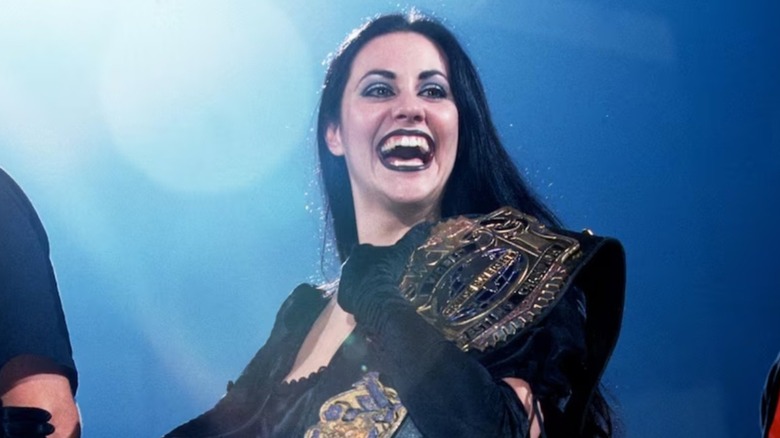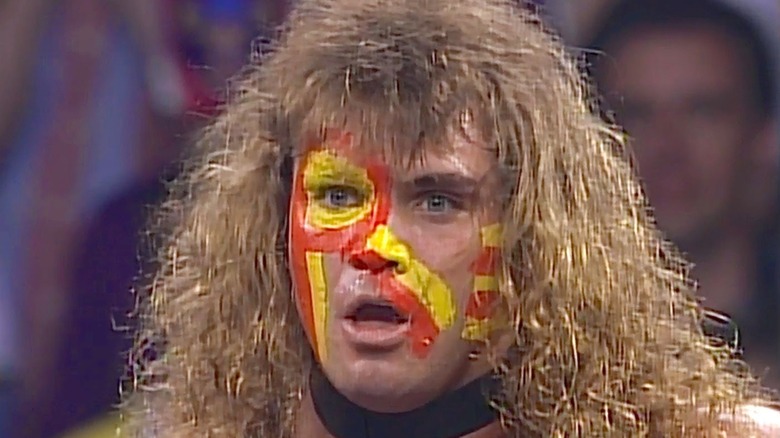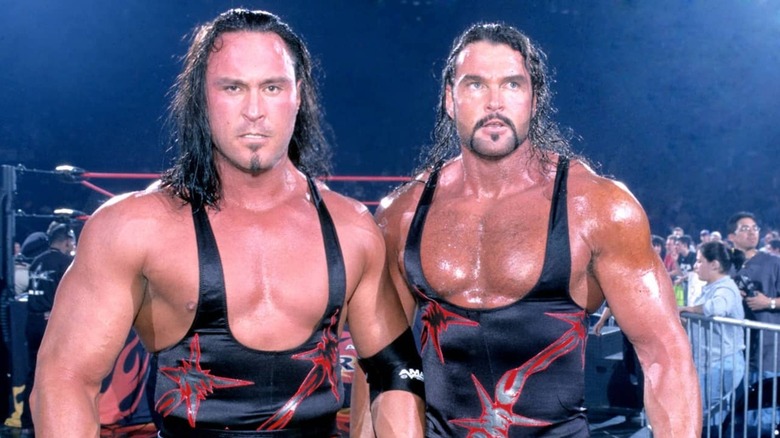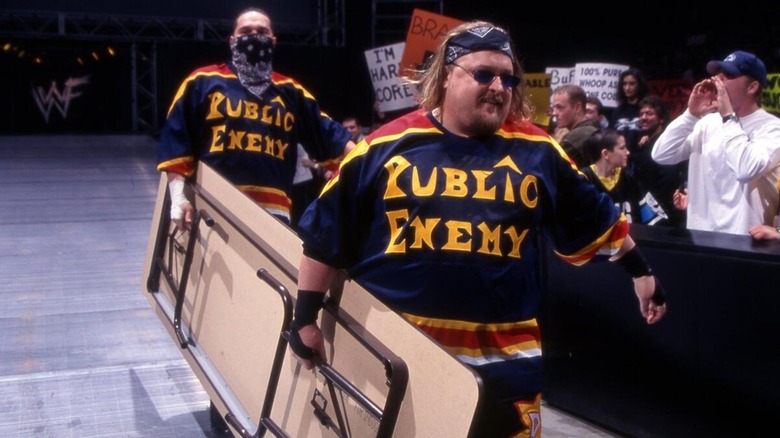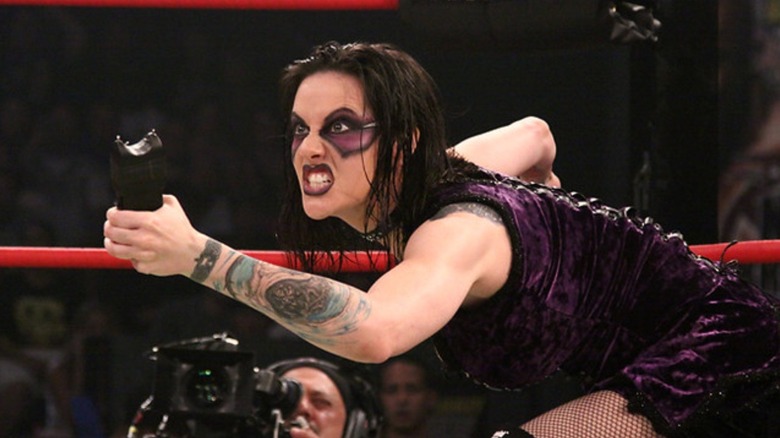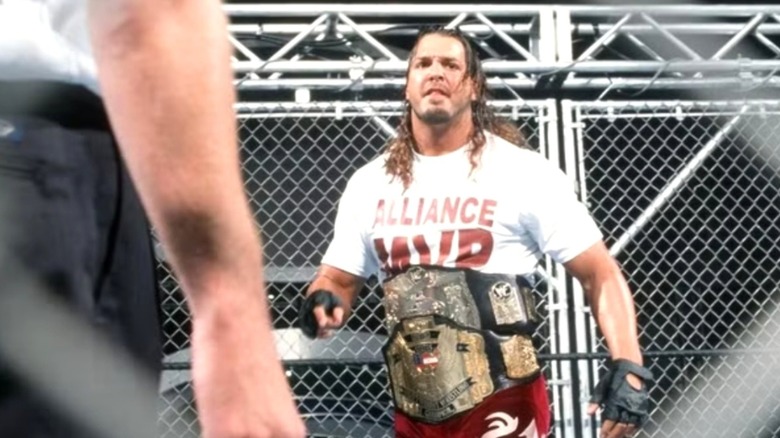WCW Stars You Might Not Know Have Died
As 2026 rapidly approaches, we are nearing the 25th anniversary of when WCW closed its doors. World Championship Wrestling held its final event on March 26, 2001, and the wrestling business simply hasn't been the same since. The constant need for WWE to up their game during the Monday Night Wars led to a boom in popularity for wrestling as a whole that hasn't been seen since, and it's only recently since the formation of All Elite Wrestling that there has been an legitimate alternative in mainstream American wrestling.
In the near quarter of a century that WCW has been gone, the former stars of the company have ventured down many different paths. Stars like Rey Mysterio are amazingly still wrestling to this day, albeit at the tale end of their respective careers. Stars like Kevin Nash have covered their WCW glory days on podcasts and radio shows, while also keeping up to date with recent wrestling trends, and the likes of Gregory Helms, Lance Storm, and Dean Malenko have all become producers and coaches in WWE, TNA, and AEW to help mould the wrestling we still watch today. However, there are far too many wrestlers who we watched as fans on WCW programming that are sadly no longer with us.
We all know that professional wrestling is a brutal business. The hyper-competitiveness of it produces backstage politics that are too much for some people to take. Accidents have happened which have caused injuries that have legitimately left people without the ability to walk, and the gruelling schedule of traveling all over the world in constant agony has led to health and legal problems which have ultimately cost some wrestlers their lives.
Over the past few years, we've bid farewell to some of the most famous faces to ever grace a WCW ring. Dusty Rhodes, Scott Hall, and even Hulk Hogan have gained their wings in recent years, but today, we are shining the light on some former WCW stars that are no longer with us whose deaths either didn't get the coverage they deserved, or had vanished from the wrestling business to the point where no one actual recalls them passing away. These are just some of the former WCW stars you didn't know had passed away.
The Renegade
When Hulk Hogan started teasing "The Ultimate Surprise" in the lead up to the WCW Uncensored 1995 pay-per-view, fans immediately got excited as there were heavy rumors at the time that The Ultimate Warrior would be making his return to wrestling, this time flying the WCW flag as opposed to the WWE flag. The Warrior would show up in WCW, just not in 1995, so who was the surprise that Hogan was teasing? That would be The Renegade.
Richard Wilson was born on October 16, 1965 in Marietta, Georgia. He had a terrible upbringing as his father was sent to prison after being involved in a serious car accident, and when his mother re-married, he was frequently beaten by his step-father. That would cause a lot of trauma for any child, and after working as an exotic male dancer, Wilson found his true calling; professional wrestling. He began learning from the legendary Killer Kowalski in 1990, though Kowalski never officially trained Wilson as that honor went to a man by the name of Richard Byrne, one of Kowalski's top students.
Wilson would have his first match in May 1990 and immediately got to work on traveling around the independent scene to try and make a name for himself. Wilson would even get the chance to wrestle for Genichiro Tenryu's WAR promotion in Japan as Rio Lord of the Jungle, where he managed to mix it up with the likes of John Tenta, Ultimo Dragon, and a young Chris Jericho. These performances impressed WCW officials enough to bring Wilson into the company in 1995 as The Renegade, a man who had such a resemblance to The Ultimate Warrior that it's a small miracle that Warrior or WWE didn't try and file a lawsuit against him.
The Renegade made an immediate impression and would go on an undefeated streak that would see him win the WCW World Television Championship from Arn Anderson at the 1995 Great American Bash pay-per-view. With that said, 1995 would be the peak of The Renegade's career as he would lose his title to Diamond Dallas Page in September, before being buried on an episode of "WCW Monday Nitro" by Jimmy Hart who had recently turned heel. Things never got better for The Renegade, and despite staying with the company until 1998, he was eventually released and began training to become a farrier.
Sadly, the depression of being released from WCW, having no offers from any other company, and the financial strain of not having a steady income started to take its toll on Wilson. Just a few months after his WCW release on February 23, 1999, Wilson was arguing with his girlfriend in their kitchen when out of nowhere, Wilson took out a pistol and shot himself in the head. At one point in time, The Renegade was one of the fastest rising stars in WCW, but life became too much to handle, and he took his own life at the age of just 33.
Brian Adams
You could make the argument that Brian Adams is known more for his work outside of WCW, but his time associated with World Championship Wrestling is the most infamous of his career due to how catastrophically bad it was.
Adams originally had his big break in Japan after being trained by the legendary founder of New Japan Pro Wrestling Antonio Inoki, to the point where his debut match was on a NJPW show in 1987. However, his initial time in Japan was short-lived due to his work visa expiring, but he continued his wrestling journey in the United States for the NWA territory Pacific Northwest Wrestling in Portland, Oregon as The American Ninja. Adams would return to Japan for both NJPW and All Japan Pro Wrestling for separate tours, but by that time WWE were already eager to sign Adams to a contract.
WWE got their man in 1989, but it wasn't until 1990 where Adams debuted on TV as Crush, the third member of Demolition, and would even get to hold the WWE Tag Team Championships thanks to Demolition having the Freebird Rule on their side. However, Demolition would disband a year later and Crush would be gone from WWE by the end of 1991, but after another successful spell in PNW, he was brought back to WWE in 1992 and would spend the next five years of his career as a member of the company (with a brief stint in jail also happening in that time).
Upon leaving WWE in 1997 due to the Montreal Screwjob, Adams would be picked up by WCW and, much like a lot of people who joined WCW at this time, became a member of the New World Order. He wasn't exactly main eventing pay-per-views as a member of the nWo, but he was getting on TV as a bodyguard for the bigger stars and picked up wins over enhancement talent. Then he got into a limousine that was supposedly occupied by the rock band KISS and everything changed. Adams became The KISS Demon for a brief period, one of the most ill-fated moves of his career, before eventually being paired up with Bryan Clark as KroniK, winning the WCW Tag Team Championships twice along the way.
People thought Adams had found his place in the wrestling business, but when KroniK were brought to WWE as part of the Invasion angle, they were put into a feud with The Undertaker and Kane that exposed them for not being up to scratch, and while Clark was immediately released, Adams would request his release after being sent to developmental. Following a short-lived return to Japan, Adams retired due to a career ending spinal injury, and tragically passed away on August 13, 2007 at the age of 43. It was determined that Adams died from combined drug intoxication as the substances found in his body were of a suitable level, but the combination of them were too much for his respiratory system to handle.
The Public Enemy
One of the few acts during the 1990s who completed the trifecta of working for WWE, WCW, and ECW, and it was in the land of extreme where The Public Enemy really made their name.
After working as opponents for many years, including a dark match that took place during the first episode of "WWE Raw" in 1993, Rocco Rock and Johnny Grunge were put together by Paul Heyman, who claims that The Public Enemy were his first original creation in ECW. They would become the most popular tag team in ECW at the time, winning the ECW Tag Team Championships on four occasions and feuding with everyone the company had to offer. Their popularity would lead them to WCW, where they had most of the mainstream exposure after spending three years with the company.
During their time in WCW, while they didn't reach the heights that they did in ECW, they still managed to bag themselves a short reign with the WCW Tag Team Championships in 1996, and landed themselves a deal with WWE in early 1999. However, things wouldn't work out in WWE as they essentially run out of the company by The Acolytes after an infamous squash match, and after a brief cameo back in ECW, The Public Enemy's time in the spotlight was over. They would continue to team up on the independent circuit, and even held the NWA Tag Team Championships after their departure from WWE, but they would never get back on TV in any capacity, then tragedy struck.
On September 21, 2002, Rocco Rock was traveling to an independent show where he was going to cross paths with fellow ECW alumni Gary Wolfe, better known as Pitbull #1. On the way to the show, Rocco would suffer a fatal heart attack that killed him at the age of 49, and despite being in locker rooms filled with steroids and other commonly used drugs, Rocco's family revealed that the heart attack was triggered by a congenital heart defect that ran through his family, and that there were no drugs found in his system at the time of death. To remember him, IWA-Mid South, founded by former ECW star Ian Rotten, changed the name of their annual Sweet Science Sixteen tournament to the Ted Petty Invitational (Ted Petty being Rocco Rock's real name) in the wake of his death. Since then stars like AJ Styles, Chris Hero, and Low Ki have all won the tournament.
As for Johnny Grunge, he would try and soldier on with his kayfabe brother Joey Grunge as The New Public Enemy, but things never really worked out for Johnny following Rocco's death, and on February 16, 2006, Grunge would also pass away at the age of 40 following a number of sleep apnea complications. While some reports suggest that Grunge died from a coronary artery blockage caused by his obesity, others claim that he had ingested a large number of Soma pills the night before his death.
Daffney
If there is one thing that we can all learn from Daffney, it's that your mental health is extremely important.
Shannon Claire Spurill was born on July 17, 1975 at an air base in West Germany, before moving back to the United States (with a brief detour to Oxford, England thrown in the middle). She would grow up with a love of all things entertaining, pursuing an acting career after graduating from Georgia State University with a degree in Film and Media Production, but life would take her on a different path as WCW put the call out for new recruits and after applying for a job, Spurill was brought to the WCW Power Plant and Daffney was born.
WCW in 2000 isn't looked back on fondly, but Daffney's appearances on "WCW Nitro" and "WCW Thunder" always made her stand out to the point where Daffney is often credited as one of the few bright spots in WCW's final days. She even became second woman in company history win the WCW Cruiserweight Championship, which might have only lasted for a little over two weeks, but she did manage to make one successful defense in that time. Luck wasn't on Daffney's side in 2001 as she was released from the company due to budget constraints, and had she managed to hang on for one more month, she would have been part of the roster that made up the line up for the final episode of "Nitro" before WWE purchased the company.
While some of her former colleagues were absorbed by WWE, Daffney went on her own adventures around the independent scene, making appearances for both Ring of Honor and TNA, before signing a WWE developmental contract in 2003, only to be let go from the company that same year, leading to her retiring from the business. It was also during this time where she was diagnosed with bipolar disorder, something that would become much more notable as the years went on. Daffney returned to wrestling in 2006 and would eventually go on to sign a full-time deal with TNA in 2008, but it was during her TNA run where she would suffer a number of concussions that would cut her career short, even suing the company for being an unsafe working environment which was eventually settled out of court.
As time went on, Daffney's mental health deteriorated, something she put down to the number of concussions she had sustained during her career that went untreated. On September 1, 2021, Daffney livestreamed herself reading a suicide note on Instagram that sent her fans into a panic, urging local law enforcements to check on her well-being, but when they arrived at her house, Daffney had taken her own life at the age of 46 via a self-inflicted gunshot wound to the chest. Since then, her brain was donated for CTE testing (something she requested during her final livestream), becoming the first female brain to be studied, where evidence of CTE was found.
Chris Kanyon
One of the most underrated wrestlers of his generation, and had he been born in a different era, Chris Kanyon could have been mixing it up at the top of a card for companies like WWE or AEW. However, he had his biggest fights away from wrestling that were sadly too big to overcome.
Christopher Klucsartis was born on January 4, 1970 in Queens, New York and was a wrestling fan from an early age. This love of wrestling pushed him into the world of fitness and physical education, leading to him graduating from the University at Buffalo with a degree in physical therapy and embarking on a career as a physical therapist while starting out his wrestling career. Throughout the week, he was Chris Klucsartis, the physical therapist who would help people recover from surgeries and get members of the public back to 100%, but on the weekends, he was Chris Kanyon, a professional wrestler who managed to make appearances in both WWE and ECW before being signed to a WCW contract in 1995.
Kanyon would spend the next six years of his career with WCW, and almost all of the success he had in his career came in those six years. He started out as an enhancement talent before being given the gimmick of Mortis, a masked wrestler who was known for his martial arts expertise who teamed up with Wrath, played by Bryan Clark who was the tag team partner of the aforementioned Brian Adams in KroniK. The Mortis gimmick never really got off the ground as well as WCW had hoped, but Kanyon's innovative offense led to him gaining a cult following, and being dubbed "The Innovator of Offense" on commentary once he dropped the Mortis gimmick.
In WCW's final years, Kanyon became an upper-midcarder and won the WCW Tag Team Championships alongside Diamond Dallas Page and Bam Bam Bigelow, to the point where he was given a major push when WWE bought out WCW in 2001 and brought Kanyon to the company. He held the WCW United States and WWE Tag Team Championships simultaneously, dubbing himself "The Alliance MVP" for being the only double champion at the time, everything was going well for Kanyon until October 2001 where he suffered a cruciate ligament injury, and his career was never the same.
Kanyon's WWE run was plagued with issues, ranging from injuries to concussions, to a failed suicide attempt that he wouldn't reveal until after his release in 2004, but it was after his WWE departure where the real fight started. Kanyon always struggled with his sexuality as he came out as gay, then took it back claiming it was a publicity stunt to get back into WWE, to coming out again. Combine this internal struggle with severe head trauma, bipolar disorder, and a long history of depression caused by concussions, Kanyon would take an entire bottle of sleeping pills and take his own life at the age of 40 on April 2, 2010.
